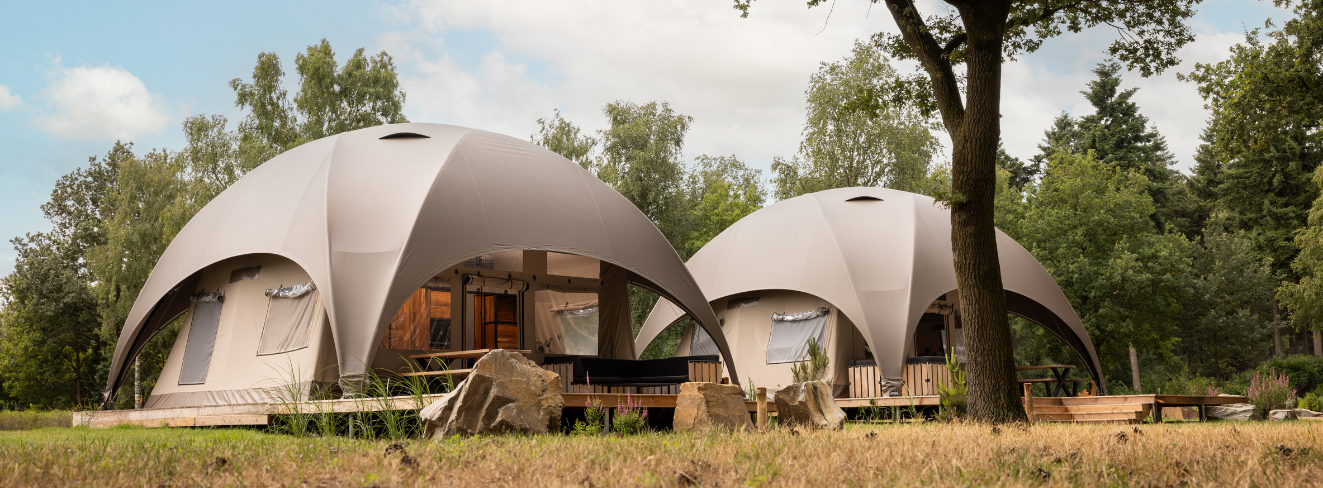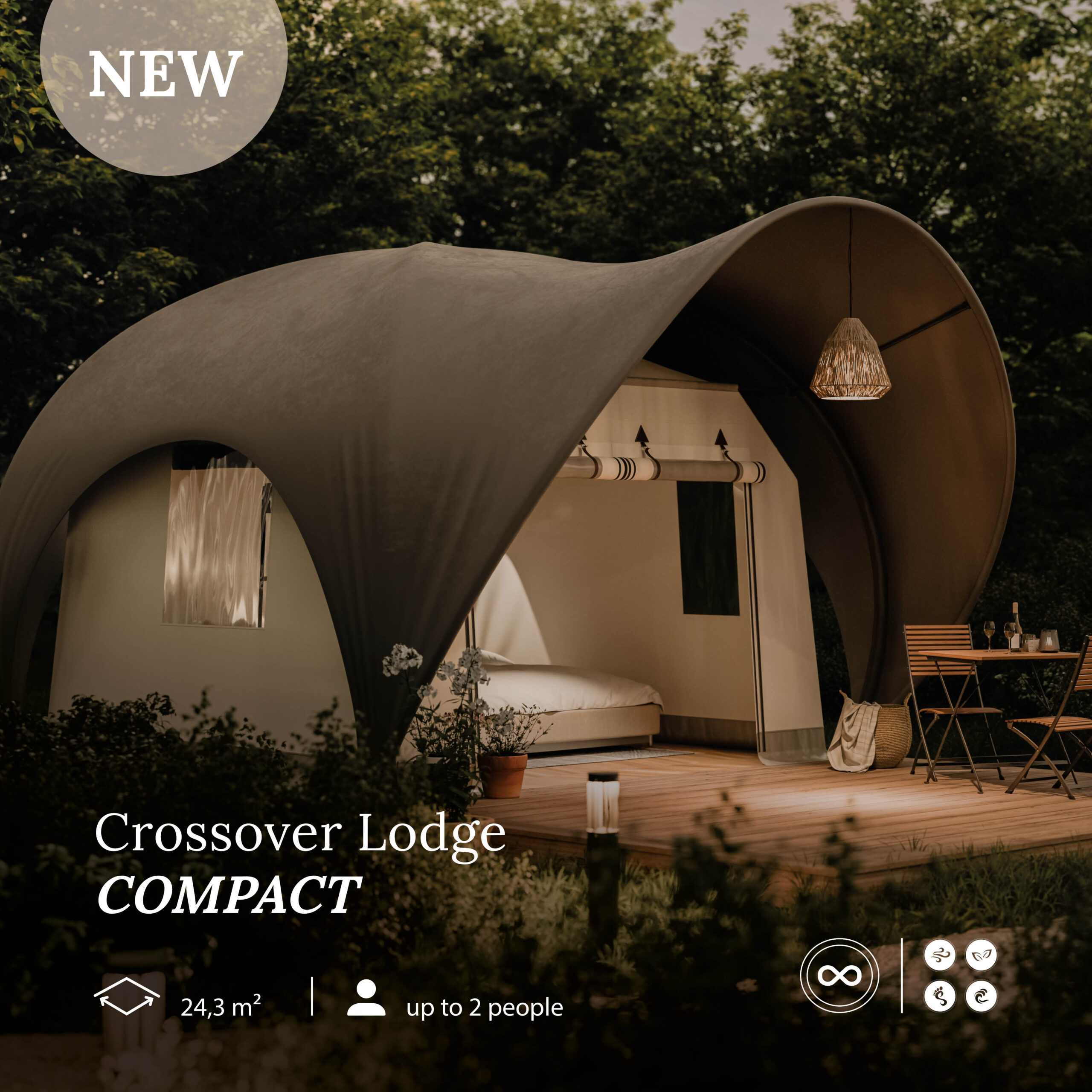As the outdoor hospitality market continues to grow, investors and entrepreneurs are increasingly exploring alternatives to traditional accommodation models. One of the fastest-rising stars is glamping. A hybrid of “glamorous” and “camping”, offering guests the immersion of nature with the comfort of upscale amenities.
But how does glamping compare to traditional camping or hotel development when it comes to Return on Investment (ROI)? Let’s break it down.
Table of contents
What are we comparing? Glamping vs hotel profitability vs camping
Before diving into numbers, it’s important to clarify what we’re analyzing:
- Glamping: Luxury tents and lodges (yurts, domes, treehouses) with en‑suite bathrooms, heating and cooling, Wi‑Fi, and upscale interiors, designed for comfort and connection with nature.
- Traditional camping: Tent pitches or RV spots with minimal amenities, like picnic tables, fire rings, and shared facilities.
- Hotels: Fixed structures with high construction costs, staff, and utilities.
This post explores glamping ROI and contrasts glamping vs hotel profitability using real international data and insights.

1. Initial investment: lean for glamping
| Category | Glamping | Traditional Camping | Hotel |
|---|---|---|---|
| Land cost | Moderate | Low | High (urban/suburban) |
| Setup cost | $10K–$50K per lodge | Minimal | $100K–$300K per room |
| Permits / zoning | Typically straightforward | Simple | Complex & expensive |
| Infrastructure | Off‑grid capable | Very basic | Full utilities, plumbing |
Glamping has a significantly lower barrier to entry than hotels and can often be developed incrementally on land already owned. Also have a look at our blogpost ‘Is glamping worth the investment’ where you can find an investment example.
| Category | Glamping | Traditional Camping | Hotel |
|---|---|---|---|
| Land cost | Moderate | Low | High (urban/suburban) |
| Setup cost | $10K–$50K per lodge | Minimal | $100K–$300K per room |
| Permits / zoning | Typically straightforward | Simple | Complex & expensive |
| Infrastructure | Off‑grid capable | Very basic | Full utilities, plumbing |
2. Operation costs
- Labor: Hotels typically require 24/7 staffing. Glamping operations can be run with a lean team, or even automated with digital check-in.
- Maintenance: Hotels have HVAC systems, elevators, and extensive plumbing. Glamping units are simpler and cheaper to maintain.
- Utilities: Glamping is often eco-friendly and off-grid, minimizing long-term utility bills.
By factoring these into your glamping ROI model, you’ll see how margins increase, especially compared to traditional hotels.

3. Revenue potential: High ADR, high margins
| Metric | Glamping ROI Focus | Camping | Hotel |
|---|---|---|---|
| Average Daily Rate | $150–$500/night | $20–$80/night | $120–$300/night |
| Occupancy Rate | 50–80% | 30–60% | 60–85% |
| Upsells | Spa, tours, kitchen, F&B | Minimal | Parking, dining, room service |
| Metric | Glamping ROI Focus | Camping | Hotel |
|---|---|---|---|
| Average Daily Rate | $150–$500/night | $20–$80/night | $120–$300/night |
| Occupancy Rate | 50–80% | 30–60% | 60–85% |
| Upsells | Spa, tours, kitchen, F&B | Minimal | Parking, dining, room service |
Thanks to luxury experiences and extended seasons (heated/cooling enabled), glamping delivers richer margins, and a faster ROI. Want to calculate your ROI? Use our ROI Calculator.
4. Scalability & market trends
Glamping is modular and quick to deploy, especially with structures like Crossover Lodge that are weather‑rated and mobile. Hotels, in contrast, demand major capital investment and long build times. Traditional camping, while scalable, remains low‑margin and reliant on seasonal peaks.
Globally, the glamping market continues its explosive rise:
- According to Vision Research Reports, the global glamping market was valued at an estimated USD 3.17 billion in 2023. This market is projected to reach approximately USD 7.31 billion by 2033, demonstrating a compound annual growth rate (CAGR) of 8.72% from 2024 to 2033.
- Another study forecasts growth from $3.08 bn (2023) to $7.94 bn by 2033 (CAGR 9.9%) (Spherical Insights)
- Post‑COVID, demand surged travelers now prioritize nature, privacy, and socially distant stays .
This is where glamping ROI sets itself apart!
5. Payback period & ROI
Let’s compare a sample investment of $200,000:
| Modèle | Startup Cost | Net Annual Profit | Payback Period | ROI (Year 5) |
|---|---|---|---|---|
| Glamping (4 units fully furnished) | $200,000 | $50,000–$80,000 | ~3–4 years | 125–200% |
| Hotel (2 rooms) | $400,000+ | $30,000–$60,000 | ~7–10 years | 50–80% |
| Camping (20 sites) | $75,000 | $15,000–$25,000 | ~3–5 years | 100–150% |
Assumes average occupancy and minimal debt financing.
Don’t forget, you can tailor your glamping investment to your exact preferences. From making it as luxurious as you desire to furnishing your glamping tent with your own personal touch. For the calculations mentioned above, we’ve based our figures on the Crossover Lodge Large, fully equipped for five people.
Explore how flexible your investment can be and see the potential returns with our ROI Glamping Calculator.
Let’s compare a sample investment of $200,000:
| Modèle | Startup Cost | Net Annual Profit | Payback Period | ROI (Year 5) |
|---|---|---|---|---|
| Glamping (4 units fully furnished) | $200,000 | $50,000–$80,000 | ~3–4 years | 125–200% |
| Hotel (2 rooms) | $400,000+ | $30,000–$60,000 | ~7–10 years | 50–80% |
| Camping (20 sites) | $75,000 | $15,000–$25,000 | ~3–5 years | 100–150% |
Assumes average occupancy and minimal debt financing.
Don’t forget, you can tailor your glamping investment to your exact preferences. From making it as luxurious as you desire to furnishing your glamping tent with your own personal touch. For the calculations mentioned above, we’ve based our figures on the Crossover Lodge Large, fully equipped for five people.
Explore how flexible your investment can be and see the potential returns with our ROI Glamping Calculator.
6. Scalability & flexibility
- Glamping is modular. You can start with a few units and expand based on demand.
- Hotels require scale to be profitable. One or two rooms don’t work.
- Camping is scalable but limited by low margins.
In addition, glamping units can often be moved or resold, offering more flexibility than fixed hotel infrastructure.
7. Risks to Consider
- Weather exposure: In general glamping units are more vulnerable to harsh climates. Except the glamping domes from Crossover Lodge. They are TÜV certified and extreme weather rated (~49 – 62 mph and ~ −22 °F / + 158 °F)
- Zoning & regulation: These vary by region and can be a hurdle.
- Market saturation: Glamping is trendy. Competition may grow quickly.
- Seasonality: Unless you’re in a year-round destination, occupancy will fluctuate.
But with strong branding, good location selection, and creative experiences, glamping can still outperform both traditional camping and hotels in ROI.
8. Final verdict: why glamping stands out
| Feature | Glamping | Camping | Hotel |
|---|---|---|---|
| Startup Cost | Medium | Low | High |
| Revenue Potential | High | Low | Medium–High |
| Flexibility | High | Medium | Low |
| Time to Launch | Short (3–6 months) | Very short | Long (12–36 months) |
| ROI Potential | High | Moderate | Low–Moderate |
Glamping offers a rare balance of low investment, high margins, and experiential appeal. It may not replace hotels, but for landowners, eco-developers, or investors looking for a high-yield, sustainable venture, glamping is a compelling alternative.
Ready to explore your Glamping ROI?
If you’re considering entering the glamping market or need help assessing potential ROI for your site, get in touch. We’d be happy to help you run the numbers. Also have a look at our ROI Calculator.
| Feature | Glamping | Camping | Hotel |
|---|---|---|---|
| Startup Cost | Medium | Low | High |
| Revenue Potential | High | Low | Medium–High |
| Flexibility | High | Medium | Low |
| Time to Launch | Short (3–6 months) | Very short | Long (12–36 months) |
| ROI Potential | High | Moderate | Low–Moderate |



